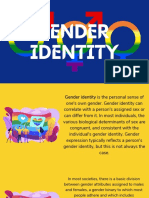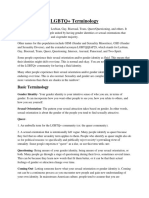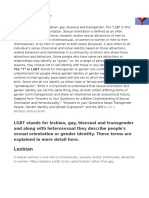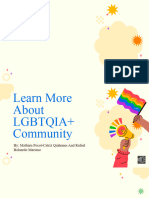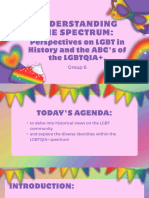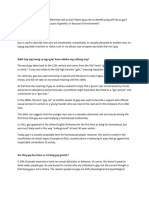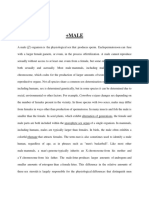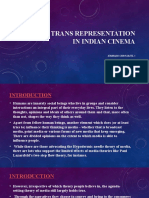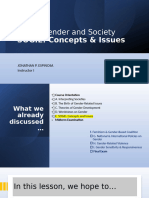0 ratings0% found this document useful (0 votes)
88 viewsInfographic
The document discusses several key terms related to sexual orientation and gender identity:
- Gay refers to a homosexual person, especially a man who is attracted to men. It originally meant carefree but took on a meaning of male homosexuality in the late 19th century.
- Lesbian usually refers to a woman who is attracted to other women. Some non-binary people also identify with this term.
- LGBTQ is an acronym that stands for Lesbian, Gay, Bisexual, Transgender, and Questioning individuals who often face societal challenges and discrimination.
- The passage then discusses a dissertation exploring the experience of LGBTQ Catholics and their coming out process in relation to practicing Catholic religious beliefs.
Uploaded by
great madCopyright
© © All Rights Reserved
Available Formats
Download as PDF, TXT or read online on Scribd
0 ratings0% found this document useful (0 votes)
88 viewsInfographic
The document discusses several key terms related to sexual orientation and gender identity:
- Gay refers to a homosexual person, especially a man who is attracted to men. It originally meant carefree but took on a meaning of male homosexuality in the late 19th century.
- Lesbian usually refers to a woman who is attracted to other women. Some non-binary people also identify with this term.
- LGBTQ is an acronym that stands for Lesbian, Gay, Bisexual, Transgender, and Questioning individuals who often face societal challenges and discrimination.
- The passage then discusses a dissertation exploring the experience of LGBTQ Catholics and their coming out process in relation to practicing Catholic religious beliefs.
Uploaded by
great madCopyright
© © All Rights Reserved
Available Formats
Download as PDF, TXT or read online on Scribd
You are on page 1/ 1
gay
Gay is a term that primarily refers to
Lesbian
Usually refers to a woman who has
a homosexual person or the trait of
a romantic and/or sexual
being homosexual. The term
orientation toward women. Some
originally meant 'carefree',
nonbinary people also identify with
'cheerful', or 'bright and showy'.
this term. GAY: Used in some
While scant usage referring to male
cultural settings to represent men
homosexuality dates to the late 19th
who are attracted to men in a
century, that meaning became
romantic, erotic and/or emotional
increasingly common by the mid-
sense.
20th century.
Lesbian, Gay, Bisexual, Transgender, Questioning
(LGBTQ) adults encounter societal challenges,
pushback from religious organizations, and
discrimination from lawmakers which interfere with
their ability to come out as their true selves. This
qualitative, phenomenologically oriented study
explored the LGBTQ identity and practicing
Catholic religious beliefs in an attempt to develop
a rich description and understanding of the
experience of LGBTQ individuals’ coming out process
in relation to the practice of Catholic religious
beliefs.
-Dissertation supervised by Fr. Louis Jocelyn Gregoire, CSSp., Ed.D
Same sex marriage
Same-sex marriage in the Philippines remains a highly contentious
issue due to the infuence of religion in this predominantly Catholic
country, where it is often framed as an issue of morality. However,
the psychological underpinnings of this religious infuence still
merits further exploration. Thus, we examined the role of religious
behaviors and moral foundations in predicting attitudes toward
same-sex marriage among Filipinos. Data from 385 participants
revealed that the particular behavior of reading the main sacred
text of one’s religion, rather than the often-used predictor of
religious attendance predicts negative attitudes. Beyond these
religious variables, the moral foundation of Purity/sanctity also
predicts negative attitudes. Recommendations for further research
and possible implications on attitude change are discussed in light
of these fndings.
You might also like
- Out of The Shadows Supporting LGBTQ Youth in Child Welfare Through Cross System Collaboration WebNo ratings yetOut of The Shadows Supporting LGBTQ Youth in Child Welfare Through Cross System Collaboration Web36 pages
- RIghts Of LGBTQ in India and the Struggle for Societal AcceptanceNo ratings yetRIghts Of LGBTQ in India and the Struggle for Societal Acceptance13 pages
- Group 8 - Topic 10 - The A-Z of Gender - Gen&socNo ratings yetGroup 8 - Topic 10 - The A-Z of Gender - Gen&soc4 pages
- CSII_Sex and Gender_ Gutierrez_20250420_172139_0000No ratings yetCSII_Sex and Gender_ Gutierrez_20250420_172139_000023 pages
- Lesbian: LGBT Is Shorthand For Lesbian, Gay, Bisexual and Transgender. The "LGB" in ThisNo ratings yetLesbian: LGBT Is Shorthand For Lesbian, Gay, Bisexual and Transgender. The "LGB" in This5 pages
- Supplement To Marriage Scripture and TheNo ratings yetSupplement To Marriage Scripture and The202 pages
- Ma. Chelo Sumanting II-BSED Social ScienceNo ratings yetMa. Chelo Sumanting II-BSED Social Science13 pages
- Social Work Practice With Gay Men, LesbianNo ratings yetSocial Work Practice With Gay Men, Lesbian30 pages
- What Does Queer Mean Anyway - The Quick and Dirty Guide to LGBTQIA+ VocabularyFrom EverandWhat Does Queer Mean Anyway - The Quick and Dirty Guide to LGBTQIA+ VocabularyNo ratings yet
- A. Sex vs. Gender B. Sexual OrientationNo ratings yetA. Sex vs. Gender B. Sexual Orientation22 pages
- Bakit Gay Ang Tawag Sa Mga Gay? Asan Nakuha Ang Salitang Gay?No ratings yetBakit Gay Ang Tawag Sa Mga Gay? Asan Nakuha Ang Salitang Gay?4 pages
- What Are The Different Types of Sexuality 47 LGBTQIA+ Terms To KnowNo ratings yetWhat Are The Different Types of Sexuality 47 LGBTQIA+ Terms To Know1 page
- Assignment 2 (Religion, Gender and Human Rights)No ratings yetAssignment 2 (Religion, Gender and Human Rights)10 pages
- 6. RELIGION, TRANSGENDER AND HOMOSEXUALITYNo ratings yet6. RELIGION, TRANSGENDER AND HOMOSEXUALITY15 pages
- 47 Terms That Describe Sexual AttractionNo ratings yet47 Terms That Describe Sexual Attraction8 pages
- Sadomasochism Accor Sadomasochism According To Freud's Psychosexual Stages of Chosexual Stages of Development TheoryNo ratings yetSadomasochism Accor Sadomasochism According To Freud's Psychosexual Stages of Chosexual Stages of Development Theory10 pages
- Moraru Adela, 2010, Social Perception of Homosexuality in Romania PDFNo ratings yetMoraru Adela, 2010, Social Perception of Homosexuality in Romania PDF5 pages
- Alaska State Board of Education Resolution 02-2023No ratings yetAlaska State Board of Education Resolution 02-20232 pages
- Money J. Two Cases of Amptutation As A ParaphiliaNo ratings yetMoney J. Two Cases of Amptutation As A Paraphilia12 pages
- Green, Richard - Robert Stoller in Memorium PDFNo ratings yetGreen, Richard - Robert Stoller in Memorium PDF10 pages
- Exercise No.5 Gender and Development Name: Angelica Pangilinan Score: Course & Year: BS PSYCH 2A Date: 12/14/2020No ratings yetExercise No.5 Gender and Development Name: Angelica Pangilinan Score: Course & Year: BS PSYCH 2A Date: 12/14/20204 pages
- A Childs Right To Be Gay - Addressing The Emotional Maltreatment100% (1)A Childs Right To Be Gay - Addressing The Emotional Maltreatment31 pages
- Ultimate-Orgasm-Techniques (Specific Dirty-Talk)No ratings yetUltimate-Orgasm-Techniques (Specific Dirty-Talk)24 pages
- National Youth Commission: Youth Organization Registration ProgramNo ratings yetNational Youth Commission: Youth Organization Registration Program2 pages
- SWOT ANALYSIS - Legal Framework in Responding Domestic ViolenceNo ratings yetSWOT ANALYSIS - Legal Framework in Responding Domestic Violence9 pages
- CSE - Gender Relations, VIolence and Staying SafeNo ratings yetCSE - Gender Relations, VIolence and Staying Safe66 pages



























